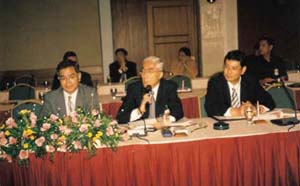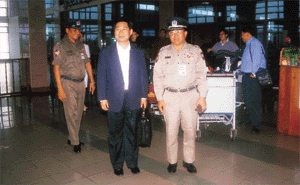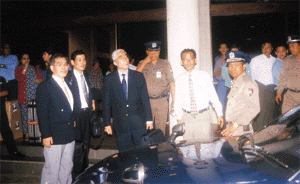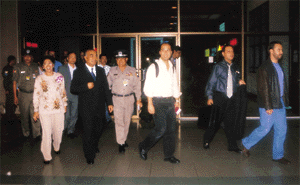|
Third-day session of 24th Meeting of Heads of National Drug Law Enforcement Agencies of Asia and the Pacific
Region (HONLEA) held
|
The third-day session of the 24th Meeting of Heads of
National Drug Law Enforcement Agencies of Asia and the Pacific Region (HONLEA),
continued at the Hotel Equatoria on 16 November 2000.
The meeting was attended by the officials of UNDCP and
INTERPOL, the delegates of ASEAN, those of the South Pacific Island Countries
Association, and leaders and members of the delegations of Australia,
Azerbaijan, People’s Republic of China, Hong Kong Special Administrative Region,
Macao Special Administrative Region, Fiji, India, Indonesia, Japan, Republic of
Korea, Lao People’s Democratic Republic, Myanmar, Malaysia, New Zealand,
Pakistan, the Philippines, Russia, Singapore, Sri Lanka, Thailand and Vietnam.
Mr. Chartchai Suthilom, officiating deputy secretary-general
of Thai Narcotic Drugs Control Board, led the group discussions on control of
stimulants and made a speech.
Next, UNDCP official Mr. Lan Munro explained the agenda of
the third-day session.
Mr. Chartchai Suthiklom gave a presentation on national
narcotic drugs control activities with the help of video slides.
Afterwards, member of Myanmar delegation Head of Department
of the Office of Strategic Studies Col. Kyaw Thein gave a presentation.
Mr Romeo Sanga of INTERPOL brought forth video slides showing
seizures of heroin and stimulants, and control activities in various parts of
the world.
The afternoon session saw group discussions on trafficking in drugs through
sea routes. Director of Japan National Police Mr. Yasunori Orita led the
discussions and made a speech.
|
|
||
| Participants
to 24th HONLEA taking part in discussions sponsored by the United Nations Drugs Control Programme (UNDCP) and hosted by Myanmar. |
|||
|
|
|
||
| Discussions
on 24th HONLEA in progress at the Hotel Equatorial in Yangon, Myanmar. |
|||
|
|
||
| A
general round of discussions being held at 24th meeting of Heads of National Drug Law Enforcement Agencies of Asia and the Pacific Region (HONLEA). |
|||
___________________________
Presentation by Col. Kyaw Thein, member
of Myanmar delegation Head of Department of the Office Strategic Studies
 |
CONTROL OF STIMULANTS
Narcotic drugs is the common enemy of mankind for it is a
phenomenon that is not confined to one country alone, for with no respect for
the sovereignty of nations, trafficking in drugs infiltrates territorial
boundaries. The Government of the Union of Myanmar has therefore designated the
fight against narcotic drugs a national cause and underscoring the need for
collaboration and cooperation, according works together with non-governmental
organizations, UN agencies, neighbouring countries as well as sub-regional and
regional countries in its crusade against the narcotic drug menace.
Myanmar, like other Southeast Asian countries, is at present,
having to contend with opium and opium-related drugs, heroin, cannabis,
stimulants such as ATS/Ecstasy and other volatile substances and inhalants.
Stimulant drugs such as ATS emerged in the region a decade ago and posed a
serious problem for Thailand, the Philippines, Japan and Korea. But Myanmar was
confronted with the threat of stimulant drugs only towards the end of 1996.
Today, transnational crime syndicates that commit grave and monstrous boundaries
and are threatening the entire world. They are exploiting the changing situation
of the world and the globalization process to step up their criminal activities.
To produce stimulants such as ATS is a simple and inexpensive
process. But the main requirements are the necessary chemicals, electrical power
and the latest machinery and equipment. In seizures made in Myanmar so far, it
has been found that conspirators abroad have supplied mechanical components
vital for the production of ATS, and that processing is done not by one
individual group alone but in collaboration with foreign partners in crime.
However considering the fact that ATS stimulants reared its head in Myanmar in
the latter half of 1996, consumption is still low. ATS stimulants can be
produced not only in the comman border areas of two countries but also in
Kitchen Laboratories (Kitchen Labs) in towns and cities. But in Myanmar, with
the exception of the seizures of one Kitchen lab in Tachilek in October 2000, no
other ATS Labs have been discovered nor captured in Myanmar so far. The problem
of ATS stimulants is not exculsive to Myanmar alone, but an international one,
and being of a totally different nature from that of traditional narcotic drugs
such as opium and heroin, it calls for a multi-national approach and cooperation
to resolve the problem.
The main precursor chemicals required for the production of
ATS which include Ephedrine, are manufactured by the two industrialized nations
in the region, India and China for legitimate industrial purposes. In addition,
it is also a known fact that precursor chemicals and controlled chemicals from
other industrialized countries also find their way into the region by all manner
of illegal means. The main precursor chemical for the production of stimulant
drugs, Ephedrine, first penetrated Myanmar from China in late 1996 and over
3,000 kilos was seized in Lashio in northern Shan State. More ephedrine arrived
from India in 1998 followed by caffeine and ATS production accessories from
neighbouring Thailand. May I take this opportunity to point out that Myanmar
lacks the technology and therefore the capacity to produce Ephedrine and other
chemical agents vital for the production of ATS. Nevertheless, Myanmar shares
lengthy common borders with the neighbours China. India and Thailand and the
terrain in these regions is rough, mountainous and thickly forested and
therefore largely inaccessible. So advantage can be taken of the isolation and
seclusion afforded by these natural barriers to smuggle in the necessary
precursor chemicals, mechanical components, electrical power generators as well
as expertise. Thus criminal associates can produce and carry on illegal drug
trafficking along the border areas to cater to the demands on the international
market.
Myanmar, as part of developing her economy, has been
promoting border trade with neighbouring countries and the fact that precursor
chemicals may enter Myanmar through these normal border trade routes is a
distinct possibility. But, there are also many overland jungle tracks and trails
through which these precursor chemicals may be brought in illegally. Under these
circumstances it is not easy for the interdiction teams at the border areas to
thoroughly seal off these gaps and control the comings and goings of
traffickers. So permission was requested of the Central Committee for Drug Abuse
Control to temporarily expropriate all dubious chemicals to be submitted for
further examination. This led to the discovery and apprehension of a large haul
of contraband chemicals. The drug control teams have therefore achieved a
measure of sucess. But there remained the possibility of legally imported
chemicals being diverted for illicit uses. To prevent this the Precursor
Chemical Control Committee was formed under the control of the Central Committee
for Drug Abuse Control, headed by the Deputy Director General of Police. The
task of this Committee is to systematically inspect and supervise the import,
conveyance, storage and use of all chemicals.
ATS tablets are simple to produce and generate large profits;
so illegal drug producers have switched to this more lucrative line of drug
production. The cost of producing one ATS tablet is a mere 30 kyats, but fetches
between 200 to 300 kyats at the border areas. In Yangon, Myanmar, the price of a
tablet is between kyat 700 to 1000 and in Bangkok it is between baht 100 to 150
apiece. It has been learnt from seizures made in the country that drug
trafficking is a two-way business. ATS tablets are smuggled out of the border
areas in Myanmar into Thailand and reciprocally the trafficking begins from
Maesot. Thailand where the stimulant drugs are purchased and brought right down
to Yangon, Myanmar. Similarly, Ephedrine tablets are purchased at source in
China to be conveyed to Muse for sale. At one time millions of ATS stimulants
were conveyed to Muse for sale. At one time millions of ATS stimulants were
conveyed in secret false compartment built into motor vehicles, but nowadays,
young women are used as carriers with each smuggling in between 20,000 to 30,000
tablets each.
For the production of ATS tablets in Myanmar Ephedrine and
Caffeine, the main precursor chemicals required and the ATS producing equipment,
are usually said to be brought in along the following routes-
-
China, Shweli- Muse- Kutkai – China / Myanmar border
areas.
-
India, Moreh- Tamu- Kale- Monywa – Mandalay – Lashio
– China / Myanmar border areas.
-
India, Moreh- Tamu – Homalin – Hpaung pyin – Kalewa
–Monywa Mandalay Lashio China/ Myanmar border areas.
-
India/ Myanmar border- Tiddim – Falam – Hakha –
Monywa – Mandalay – Lashio – China/ Myanmar border areas.
-
Thailand, Maesai – Tachilek – Thai / Myanmar border
areas.
ATS tablets are said to be smuggled form the Myanmar / Thai
border aras into neighbouring China , India and Thailand along the following
routes-
-
China/Myanmar border areas- Muse – Kutkai – Lashio –
Mandalay – Taunggyi – Kyaingtong Tachilek Thailand.
-
China / Myanmar border areas- Muse – Kutkai – Loilem
– Kyaingtong – Monghpyat- Tachilek – Thailand.
-
China/ Myanmar border areas – Lashio – Mogok – Mandalay-
Han Myintmo (diversion from Kyaukse) – Aung Pan – Taunggyi- Kyaingtong-
Tachilek- Thailand.
-
China /Myanmar border areas – Lashio – Tangyang –
Loilem – Tounggyi – Kyaingtong – Tachilek – Thailand.
-
China / Myanmar border areas- via routes along the
border- Kyanigtong – Tachilek – Thailand.
-
China / Myanmar border areas- China.
-
China / Myanmar border areas- Lashio- Mandalay- Monywa-
Kale- India.
-
Thai / Myanmar border areas – Thailand.
Since the Government of the Union of Myanmar had designated
the fight against narcotic drug a National Task, narcotic drug control and
suppression measures were intensified within the country after 1988. When in
1996, the illicit production and trafficking of stimulant drugs made its
apperance, greater priority was given for implementing stronger measure for
control and suppression. As a result, the amount of stimulant drugs seized up to
September 2000 is as given below:-
| Stimulant
Tablets ( In millions ) |
Ephedrine
(Kilos) |
Caffine
(Kilos) |
|
| 1996 | 5.906 | – | – |
| 1997 | 5.028 | 2420 | – |
| 1998 | 16.206 | 3819 | – |
| 1999 | 28.887 | 6485 | – |
| 2000 ( Up to Sept.) | 22.820 | 2657 | 2022 |
|
Total |
78.670 | 15381 | 2022 |
Being thus confronted with this new problem of stimulant
tablets the Government has taken measures that include conducting and
participating in workshops both at home and abroad; it has drawn up and
accordingly implemented special plans and programmes to prevent the penetration
of stimulant drug use among students and youths; it has enhanced cooperation not
only with neighbouring countries but also with countries in the region; and has
cooperated with non-governmental organizations both local and international, to
carry out, not only narcotic drug control but also educative activities which
are given the highest priority.
Synthetic drugs generally known as ATS are produced
principally on a base of precursor chemicals and have a greater impact than
natural organic narcotic such as opium and marijuana. So to control synthetic
durgs there must be effective control of precursor chemicals. The equation then
is quite clear-” No precursors, no drugs”. We should
also keep in mind the question of consumption and demand. If there is a market
for narcotic drugs, there will always be production to meet the demand. Each
nation should take note of this and following a balanced approach between
demand and supply take measures to bring both to an end simultaneously. Now that
the deadline set for a Drug Free ASEAN has been advanced from 2020 to 2015,
it is imperative that nations in the region including Myanmar cooperate closely
to resolve the pressing problem of ATS stimulants, which threaten us all today.
It is only through such cooperation that we can hope to achieve the goal of a “Drug
Free ASEAN by 2015”

|
Discussions
on 24th HONLEA in progress.
______________________________


